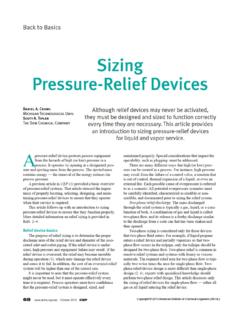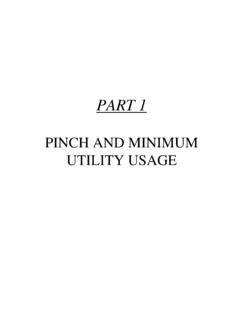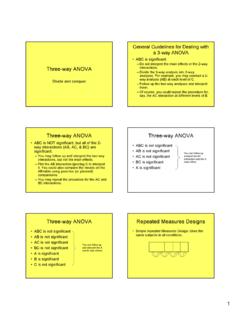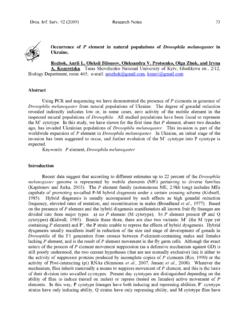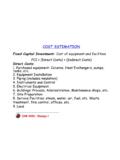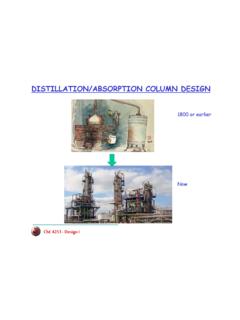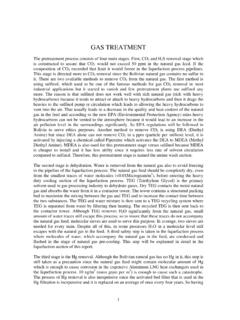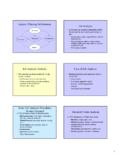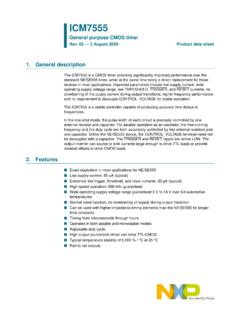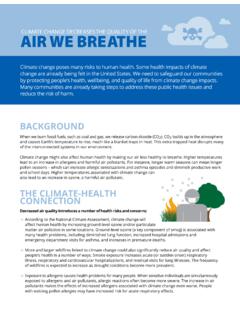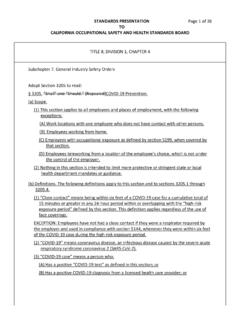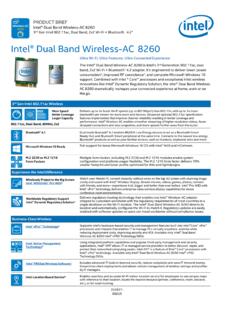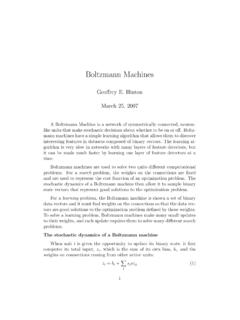Transcription of Introduction to Pinch Technology-LinhoffMarch
1 Introduction to Pinch Technology Copyright 1998 Linnhoff March Linnhoff March Targeting House Gadbrook Park Northwich, Cheshire CW9 7UZ, England Tel: +44 (0) 1606 815100 Fax: +44 (0) 1606 815151 1 What this paper contains This document aims to give an overview of the fundaments of Pinch Technology. The reader will learn: How to obtain energy targets by the construction of composite curves. The three rules of the Pinch principle by which energy efficient heat exchanger network designs must abide. About the capital-energy trade off for new and retrofit designs. Of the best way to make energy saving process modifications. How to go about multiple utility placement. How best to integrate distillation columns with the background process. The most suitable way to integrate heat engines and heat pumps.
2 The principles of data extraction. Some of the techniques applied in a study of a total site. The text covers all of the aspects of the technology in PinchExpress, as well as going on to detail theory employed in the SuperTarget suite from Linnhoff March [4]. This suite allows the user to carry out an in depth Pinch analysis, using the Process, Column and Site modules. See the relevant pages of the Linnhoff March Web site or contact Linnhoff March for more details. Introduction to Pinch Technology 2 Copyright 1998 Linnhoff March Table of Contents 1 WHAT THIS PAPER 1 2 WHAT IS Pinch TECHNOLOGY? .. 4 3 FROM FLOWSHEET TO Pinch 5 Data Extraction Flowsheet .. 5 Thermal Data .. 5 4 ENERGY 6 Construction of Composite Curves .. 6 Determining the Energy Targets .. 7 The Pinch 5 TARGETING FOR MULTIPLE 9 The Grand Composite Curve.
3 9 Multiple Utility Targeting with the Grand Composite Curve .. 11 6 CAPITAL - ENERGY 12 New Designs .. 12 Retrofit .. 14 7 PROCESS 21 The plus-minus principle for process modifications .. 21 Distillation Columns .. 23 8 PLACEMENT OF HEAT ENGINES AND HEAT 26 Appropriate integration of heat 26 Appropriate integration of heat pumps .. 28 9 HEAT EXCHANGER NETWORK 30 The Difference Between Streams and Branches .. 31 The Grid Diagram for heat exchanger network 32 The New Design Method .. 33 Heat Exchanger Network Design for Retrofits .. 39 10 DATA EXTRACTION 47 Do not carry over features of the existing solution .. 48 Do not mix streams at different temperatures .. 49 Extract at effective 50 Extract streams on the safe side .. 51 Do not extract true utility 52 Identify soft data ..52 11 TOTAL SITE 53 Total site data extraction.
4 54 Total site analysis .. 56 Selection of options: Total Site Road Map .. 59 12 62 List of Figures FIGURE 1: "ONION DIAGRAM" OF HIERARCHY IN PROCESS 4 FIGURE 2: DATA EXTRACTION FOR Pinch 5 FIGURE 3: CONSTRUCTION OF COMPOSITE 7 FIGURE 4: USING THE HOT AND COLD COMPOSITE CURVES TO DETERMINE THE ENERGY 7 FIGURE 5: THE Pinch 8 FIGURE 6: USING COMPOSITE CURVES FOR MULTIPLE UTILITIES 9 FIGURE 7: CONSTRUCTION OF THE GRAND COMPOSITE 10 FIGURE 8: USING THE GRAND COMPOSITE CURVE FOR MULTIPLE UTILITIES 11 FIGURE 9: VERTICAL HEAT TRANSFER BETWEEN THE COMPOSITE CURVES LEADS TO MINIMUM NETWORK SURFACE 13 FIGURE 10: THE TRADE-OFF BETWEEN ENERGY AND CAPITAL COSTS GIVES THE OPTIMUM DTMIN FOR MINIMUM COST IN NEW 14 FIGURE 11: CAPITAL ENERGY TRADE OFF FOR RETROFIT 15 FIGURE 12: AREA EFFICIENCY 16 FIGURE 13: TARGETING FOR RETROFIT 16 Introduction to Pinch Technology 3 FIGURE 14: TARGETING FOR RETROFIT FIGURE 15.
5 EFFECT OF SHAPE OF COMPOSITE CURVES ON OPTIMUM PROCESS FIGURE 16: MODIFYING THE PROCESS, (A) THE +/- PRINCIPLE FOR PROCESS MODIFICATIONS (B) TEMPERATURE CHANGES CAN AFFECT THE ENERGY TARGETS ONLY IF STREAMS ARE SHIFTED THROUGH THE FIGURE 17: PROCEDURE FOR OBTAINING COLUMN GRAND COMPOSITE FIGURE 18: USING COLUMN GRAND COMPOSITE CURVE TO IDENTIFY COLUMN FIGURE 19: APPROPRIATE INTEGRATION OF A DISTILLATION COLUMN WITH THE BACKGROUND FIGURE 20: APPROPRIATE PLACEMENT PRINCIPLE FOR HEAT FIGURE 21: PLACEMENT OF STEAM AND GAS TURBINES AGAINST THE GRAND COMPOSITE FIGURE 22: PLACEMENT OF HEAT FIGURE 23: A POINTED NOSE AT THE PROCESS OR UTILITY Pinch INDICATES A GOOD HEAT PUMP FIGURE 24: KEY STEPS IN Pinch FIGURE 25: THE GRID DIAGRAM FOR EASIER REPRESENTATION OF THE HEAT EXCHANGER NETWORK32 FIGURE 26: GRID DIAGRAM FOR THE EXAMPLE FIGURE 27: CRITERIA FOR TEMPERATURE FEASIBILITY AT THE FIGURE 28: NETWORK DESIGN BELOW THE FIGURE 29: COMPLETED MER NETWORK DESIGN BASED ON Pinch DESIGN FIGURE 30: CRITERIA FOR STREAM SPLITTING AT THE Pinch BASED ON NUMBER OF STREAMS AT THE FIGURE 31: INCOMING STREAM SPLIT TO COMPLY WITH CPOUT = CPIN FIGURE 32: A SUMMARY OF STREAM SPLITTING PROCEDURE DURING NETWORK FIGURE 33: A HEAT LOAD FIGURE 34: A HEAT LOAD FIGURE 35: USING A PATH TO REDUCE UTILITY FIGURE 36: HIERARCHY OF RETROFIT FIGURE 37: DELETE EXISTING NETWORK BEFORE APPLYING THE Pinch DESIGN FIGURE 38: PROCEDURE FOR CORRECTING CROSS- Pinch FIGURE 39: EXAMPLE FOR RETROFIT DESIGN USING CROSS- Pinch FIGURE 40: PINCHES REPORT INDICATE THAT THE MOST SIGNIFICANT Pinch REGION IS (HP-STEAM (GEN)).
6 42 FIGURE 41: THE LARGEST PENALTY AT IS EXCHANGER FIGURE 42: THE BENEFIT REPORTED AFTER DELETING EXCHANGER FDEF AND COOLER FIGURE 43: THE SAVINGS ACHIEVED AFTER COMPLETING THE FIGURE 44: EXAMPLE REQUIRING PATH ANALYSIS FOR RETROFIT FIGURE 45: PARALLEL COMPOSITE CURVES WITH NO INTERMEDIATE FIGURE 46: PATHS IN THE EXISTING FIGURE 47: MODIFYING TWO PATHS SAVES FIGURE 48: DRAG AND DROP OF EXCHANGER TO A NEW POSITION IMPROVES DRIVING FORCE ON PATH FIGURE 49: WITH DRIVING FORCES improved , THE TWO PATHS CAN NOW BE USED TO ACHIEVE THE FULL SAVINGS FIGURE 50: FINAL RETROFIT FIGURE 51: EXAMPLE PROCESS FIGURE 52: ORIGINAL DATA EXTRACTION AND FIGURE 53: improved DATA EXTRACTION AND FIGURE 54: MIXING AT DIFFERENT temperatures MAY INVOLVE IN-EFFICIENT CROSS- Pinch HEAT TRANSFER THUS INCREASING THE ENERGY FIGURE 55: ISOTHERMAL MIXING AVOIDS CROSS- Pinch HEAT TRANSFER SO DO NOT MIX AT DIFFERENT FIGURE 56: EVERY STREAM MUST BE EXTRACTED AT THE TEMPERATURE AT WHICH IT IS AVAILABLE TO OTHER PROCESS FIGURE 57: STREAM LINEARISATION, A) AND B) COULD BE INFEASIBLE, C) IS SAFE SIDE FIGURE 58: STREAM DATA EXTRACTION FOR SOFT DATA.
7 53 FIGURE 59: SCHEMATIC OF A SITE, SHOWING PRODUCTION PROCESSES WHICH ARE OPERATED SEPARATELY FROM EACH OTHER BUT ARE LINKED INDIRECTLY THROUGH THE UTILITY FIGURE 60: CONSTRUCTION OF TOTAL SITE PROFILES FROM PROCESS GRAND COMPOSITE CURVES55 FIGURE 61: TOTAL SITE TARGETING FOR FUEL, CO-GENERATION, EMISSIONS AND Introduction to Pinch Technology 4 Copyright 1998 Linnhoff March FIGURE 62: EXISTING 57 FIGURE 63: PROPOSED EXPANSION OF THE SITE INVOLVING ADDITION OF A NEW 58 FIGURE 64: ALTERNATIVE OPTION BASED ON TOTAL SITE 58 FIGURE 65: TOTAL SITE ROAD 60 FIGURE 66: KEY STEPS IN TOTAL SITE 60 2 What is Pinch Technology? Pinch Technology provides a systematic methodology for energy saving in processes and total sites. The methodology is based on thermodynamic principles. Figure 1 illustrates the role of Pinch Technology in the overall process design.
8 The process design hierarchy can be represented by the onion diagram [2, 3] as shown below. The design of a process starts with the reactors (in the core of the onion). Once feeds, products, recycle concentrations and flowrates are known, the separators (the second layer of the onion) can be designed. The basic process heat and material balance is now in place, and the heat exchanger network (the third layer) can be designed. The remaining heating and cooling duties are handled by the utility system (the fourth layer). The process utility system may be a part of a centralised site-wide utility system. Figure 1: "Onion Diagram" of hierarchy in process design A Pinch Analysis starts with the heat and material balance for the process. Using Pinch Technology, it is possible to identify appropriate changes in the core process conditions that can have an impact on energy savings (onion layers one and two).
9 After the heat and material balance is established, targets for energy saving can be set prior to the design of the heat exchanger network. The Pinch Design Method ensures that these targets are achieved during the network design. Targets can also be set for the utility loads at various levels ( steam and refrigeration levels). The utility levels supplied to the process may be a part of a centralised site-wide utility system ( site steam system). Pinch Technology extends to the site level, wherein appropriate loads on the various steam mains can be identified in order to minimise the site wide energy consumption. Pinch Technology therefore provides a consistent methodology for energy saving, from the basic heat and material balance to the total site utility system. Introduction to Pinch Technology 5 3 From Flowsheet to Pinch Data PinchExpress carries out automatic data extraction from a converged simulation.
10 What follows here is a brief overview of how flowsheet data are used in Pinch analysis. Data extraction is covered in more depth in "Data Extraction Principles" in section 10. Data Extraction Flowsheet Data extraction relates to the extraction of information required for Pinch Analysis from a given process heat and material balance. Figure 2(a) shows an example process flow-sheet involving a two stage reactor and a distillation column. The process already has heat recovery, represented by the two process to process heat exchangers. The hot utility demand of the process is 1200 units (shown by H) and the cold utility demand is 360 units (shown by C). Pinch Analysis principles will be applied to identify the energy saving potential (or target) for the process and subsequently to aid the design of the heat exchanger network to achieve that targeted saving.
